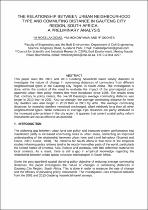 ResearchSpace
ResearchSpace
The relationship between urban neighbourhood type and commuting distance in Gauteng City region, South Africa. A preliminary analysis
JavaScript is disabled for your browser. Some features of this site may not work without it.
- ResearchSpace
- →
- Research Publications/Outputs
- →
- Conference Publications
- →
- View Item
| dc.contributor.author |
Moselakgomo, M

|
|
| dc.contributor.author |
Mokonyama, Mathetha T

|
|
| dc.contributor.author |
Okonta, F

|
|
| dc.date.accessioned | 2017-10-02T09:52:58Z | |
| dc.date.available | 2017-10-02T09:52:58Z | |
| dc.date.issued | 2013-07 | |
| dc.identifier.citation | Moselakgomo, M., Mokonyama, M.T. and Okonta, F. 2017. The relationship between urban neighbourhood type and commuting distance in Gauteng City region, South Africa. A preliminary analysis. Southern African Transport Conference 2017, 10-13 July 2017, CSIR International Convention Centre, Pretoria | en_US |
| dc.identifier.uri | Southern African Transport Conference 2017, 10-13 July 2017, CSIR International Convention Centre | |
| dc.identifier.uri | http://www.satc.org.za/assets/2b_moselakgomo.pdf | |
| dc.identifier.uri | http://hdl.handle.net/10204/9621 | |
| dc.description | Southern African Transport Conference 2017, 10-13 July 2017, CSIR International Convention Centre, Pretoria | en_US |
| dc.description.abstract | This paper uses the 2001 and 2013 Gauteng household travel survey datasets to investigate the nature of change in commuting distances of commuters from different neighbourhood types in the Gauteng City Region, in South Africa. The investigation is done within the context of the need to evaluate the impact of the promulgated post-apartheid urban form policy reforms that were introduced since 1995. The results show that, contrary to policy intents, the overall Gauteng’s average commuting distance was longer in 2013 than in 2001. Also surprisingly, the average commuting distance for inner city dwellers was also longer in 2013 than in 2001 by 40%. The average commuting distances for township dwellers remained unchanged, albeit relatively long than all other neighbourhood types. While increases in average trips distances are partly attributed to the increased poly-centrism in the city region, it appears that current spatial policy reform instruments are not as effective as intended. | en_US |
| dc.language.iso | en | en_US |
| dc.publisher | www.satc.org.za | en_US |
| dc.relation.ispartofseries | Worklist;19470 | |
| dc.subject | Gauteng household travel survey datasets | en_US |
| dc.subject | Commuting distances | en_US |
| dc.subject | Township dwellers | en_US |
| dc.title | The relationship between urban neighbourhood type and commuting distance in Gauteng City region, South Africa. A preliminary analysis | en_US |
| dc.type | Conference Presentation | en_US |
| dc.identifier.apacitation | Moselakgomo, M., Mokonyama, M. T., & Okonta, F. (2013). The relationship between urban neighbourhood type and commuting distance in Gauteng City region, South Africa. A preliminary analysis. www.satc.org.za. http://hdl.handle.net/10204/9621 | en_ZA |
| dc.identifier.chicagocitation | Moselakgomo, M, Mathetha T Mokonyama, and F Okonta. "The relationship between urban neighbourhood type and commuting distance in Gauteng City region, South Africa. A preliminary analysis." (2013): http://hdl.handle.net/10204/9621 | en_ZA |
| dc.identifier.vancouvercitation | Moselakgomo M, Mokonyama MT, Okonta F, The relationship between urban neighbourhood type and commuting distance in Gauteng City region, South Africa. A preliminary analysis; www.satc.org.za; 2013. http://hdl.handle.net/10204/9621 . | en_ZA |
| dc.identifier.ris | TY - Conference Presentation AU - Moselakgomo, M AU - Mokonyama, Mathetha T AU - Okonta, F AB - This paper uses the 2001 and 2013 Gauteng household travel survey datasets to investigate the nature of change in commuting distances of commuters from different neighbourhood types in the Gauteng City Region, in South Africa. The investigation is done within the context of the need to evaluate the impact of the promulgated post-apartheid urban form policy reforms that were introduced since 1995. The results show that, contrary to policy intents, the overall Gauteng’s average commuting distance was longer in 2013 than in 2001. Also surprisingly, the average commuting distance for inner city dwellers was also longer in 2013 than in 2001 by 40%. The average commuting distances for township dwellers remained unchanged, albeit relatively long than all other neighbourhood types. While increases in average trips distances are partly attributed to the increased poly-centrism in the city region, it appears that current spatial policy reform instruments are not as effective as intended. DA - 2013-07 DB - ResearchSpace DP - CSIR KW - Gauteng household travel survey datasets KW - Commuting distances KW - Township dwellers LK - https://researchspace.csir.co.za PY - 2013 T1 - The relationship between urban neighbourhood type and commuting distance in Gauteng City region, South Africa. A preliminary analysis TI - The relationship between urban neighbourhood type and commuting distance in Gauteng City region, South Africa. A preliminary analysis UR - http://hdl.handle.net/10204/9621 ER - | en_ZA |





